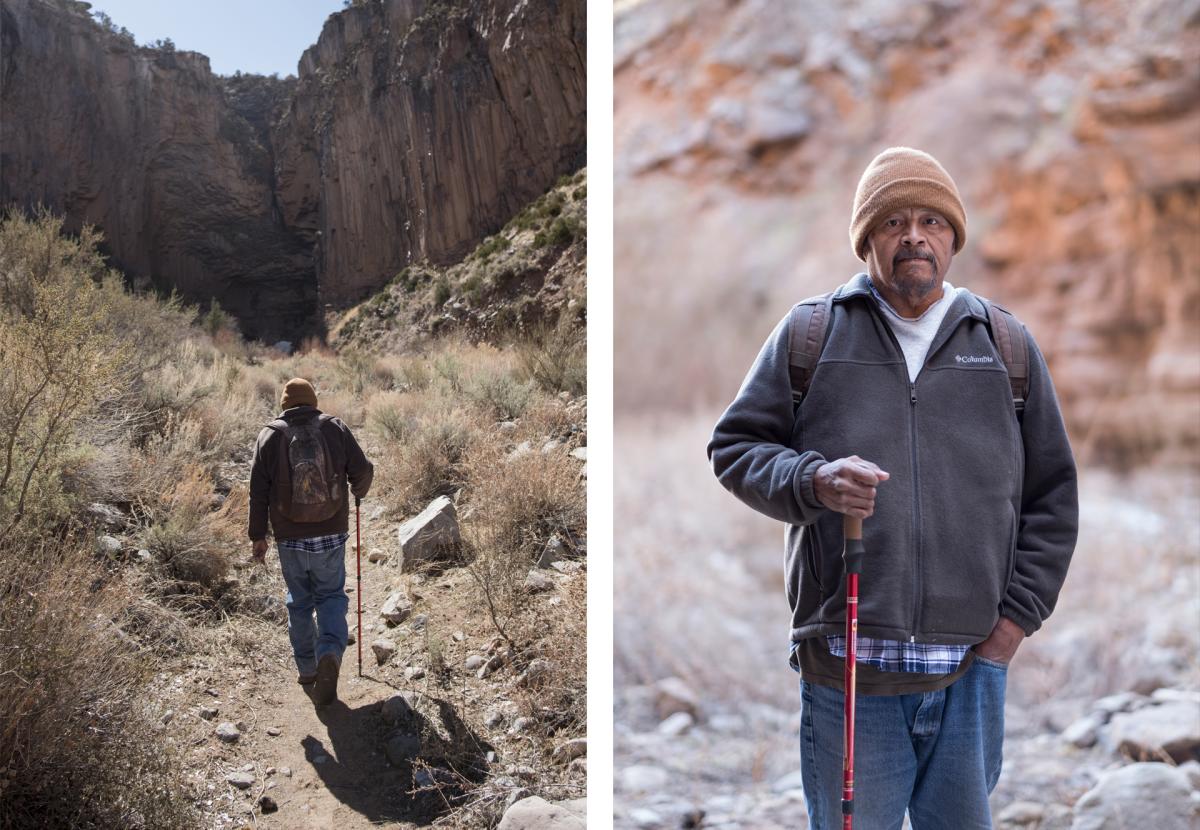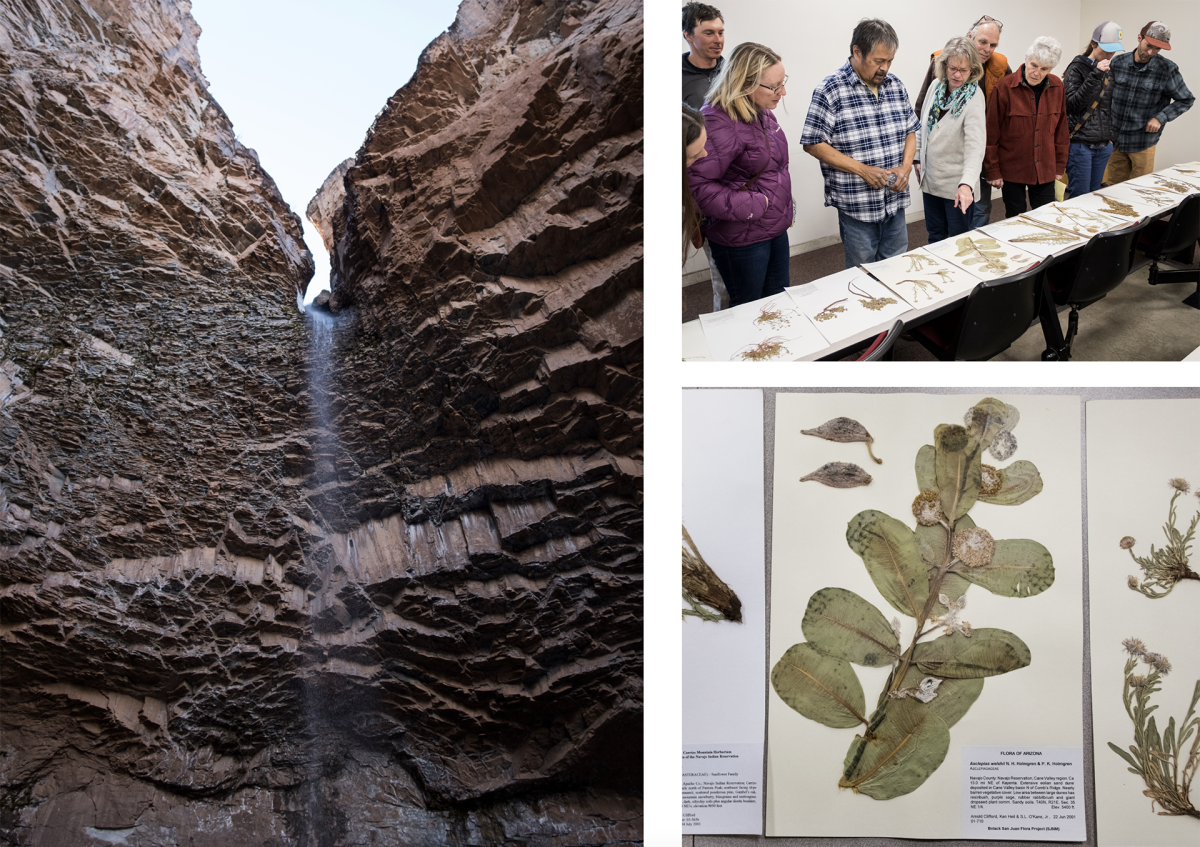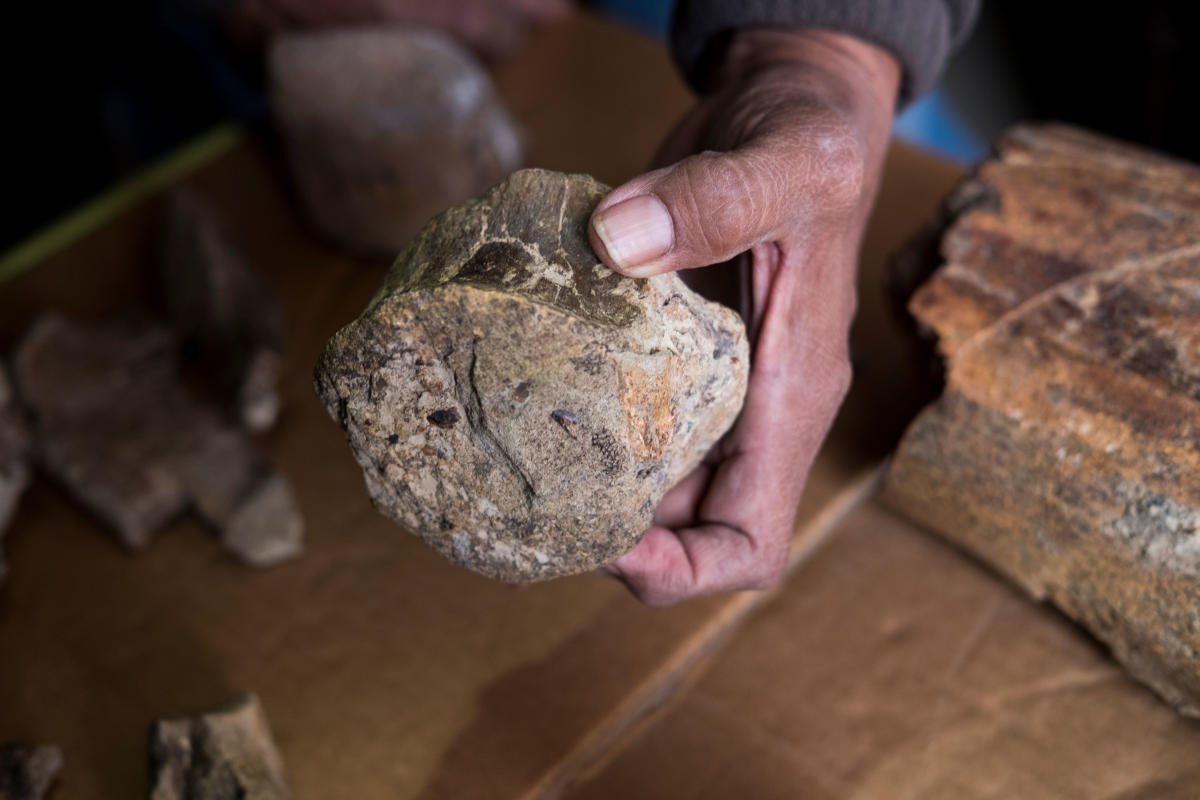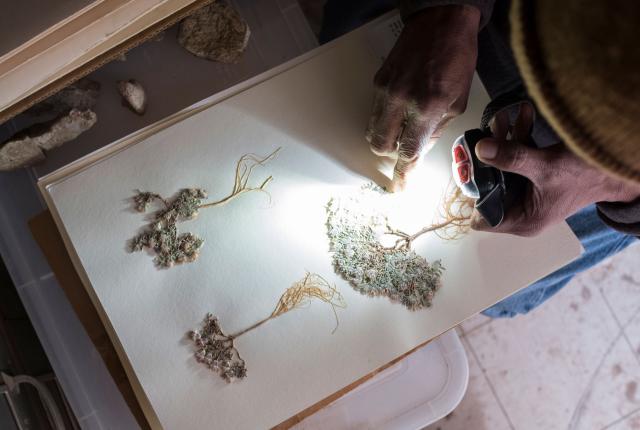WITH A HEADLAMP STRAPPED to his forehead, Arnold Clifford weaves through aisles of large filing cabinets, some nearly as tall as the room’s ceiling, all at least a couple of decades old. “These need to be filed. These need labels. And this whole box here, they’re new species,” Clifford says, pulling out drawers with a loud metal clang and pointing at large stacks of cardboard, manila folders, and newspapers, all piled on the floor, in weathered plastic bins, and on top of cabinets.
The beam from his headlamp darts through the darkness of his storage area in Beclabito, a town on the Navajo Nation about 50 miles west of Farmington, against the Arizona state line. He shuffles through some of the neater piles, and even those seem like chaos, making sense only to him. Altogether, they hold a treasure trove: his collection of 24,000 plant species from the Four Corners area of the Colorado Plateau and, in particular, the Navajo Nation.
He considers each labeled plant precious. The 54-year-old botanist and geologist focuses on documenting everything he finds using his traditional Navajo understanding of nature and science, along with Western scientific methods. By weaving the two together—literally in English and the Diné language—he constructs a fuller story of this vast land, which he hopes will change the scientific narrative by adding what academia often leaves out.
Clifford combs the hills, mesas, mountains, and valleys to collect specimens for his personal collection, as well as the Navajo Nation Herbarium and collections at five universities: San Juan College, New Mexico State University, the University of New Mexico, Northern Arizona University, and Brigham Young University. He speaks at universities and schools, both on the Navajo Nation and throughout the country. His goals, always, are to expand knowledge and nurture a more inclusive understanding of the natural world.
Clifford’s personal storage area is an abandoned house with no electricity. The backdrop is the Carrizo Mountains, and cellphone service here is spotty to nonexistent. He may have a photographic memory, given the way he spouts names and locations for dozens of plants he showcases on my private tour. But some plants are more memorable than others.
“This one is named after me, Senecio cliffordii,” he says, cracking open a manila folder holding four small plant specimens with short roots attached. It’s a rare plant, now dull green and pale yellow, dehydrated and pressed flat. In the wild, near Bowl Canyon, on the reservation, it’s a small cluster of green felt-like leaves with clusters of small yellow flowers.
Rare plants like these he files in a special place: large metal cabinets that were given to him by Harvard University. “These cabinets are over 100 years old,” he says. “Just imagine all those top scientists opening these cabinets.” He pauses, daydreaming about what was discovered and uncovered in and around these cabinets, then returns to the present and starts looking for another plant named after him.
“Aliciella cliffordii. Sometimes ‘Clifford’s Diné Star.’ It’s also called the ‘beauty way smoke,’” he says, opening another manila folder. “I’m going to start adding the Navajo names to the folders, too.” Its Diné name, he says, is hozhoji natoh, and it’s another rare plant that was previously “undiscovered” and undescribed, until Clifford got his hands on it in 2012. His tribe already knew it as a ceremonial plant, but it was overlooked by earlier botanists, who carried East Coast biases into a place with more layers of history and meaning than they could discern. “Everything goes back to them inventing things, discovering mathematics, astronomy, every aspect of life and science—they make it look as if they’ve ‘invented’ all of it,” Clifford says.
Diné science, and that of other tribes, is never acknowledged in schools and universities, he says. Yet it tells us so much about the world. You won’t find it in texts; it lives and breathes in storytelling and in ceremonies. “We have stories about every bit of it,” Clifford says about the earth, plants, people, animals, and skies. “Very extensive stories. They’re not just little tales.”
 Arnold Clifford hikes to Twin Falls, near Teec Nos Pos, Arizona, in the foothills of the Carrizo Mountains.
Arnold Clifford hikes to Twin Falls, near Teec Nos Pos, Arizona, in the foothills of the Carrizo Mountains.
HERE’S A STORY CLIFFORD has heard all his life. He comes, his family tells him, from seven or eight generations of Navajo ethnobotanists—people who study the traditional relationships between plants and local communities. In the fourth or fifth generation was Solau Alth Tsosi, a tall, thin man who was part of the first corps of Navajo Police. He was born at Fort Sumner during the Navajo imprisonment there, before 1868. When his people were released and began the 350-mile walk home, the boy fell ill. His family thought he had died. They placed him under a juniper tree by a broad-pad cactus and turned to continue their journey. But the boy cried, and, hearing him, his family rushed back and nursed him to health with the fruit of the cactus. Years later, when Solau was told the story, he vowed to learn about every plant he could. He became a medicine man and shared his plant knowledge with his daughters.
Clifford learned much of what he knows about Navajo ethnobotany from his grandmother Sarah Charley, Solau’s granddaughter. Beginning when he was nine, she taught him about edible plants, plants used to make dyes, utilitarian plants, medicinal plants, ceremonial plants, plants that provide protection, and plants used in warfare.
In 1989, he decided to study botany at San Juan College, in Farmington, where his interest in collecting plants was kindled. He told then botany professor Kenneth Heil that he would catalog all the plants in the Carrizo Mountains within a month, or at least within a summer. “It’s been over 30 years and I still haven’t completed the whole thing,” he says.
There are, it turns out, thousands of plant species in that area alone, and since then his area of focus has broadened, spreading to the Chuska Mountains, Navajo Mountain, Black Mesa, the Zuni Mountains, the Abajo Mountains, and up north to Colorado’s alpine country—basically, all of the Colorado Plateau. And he’s searched farther than that, into southern New Mexico, southern Arizona, and parts of California. At various times, he’s focused only on natural hanging gardens, or southern Utah, or the San Juan River drainage. He helped write 2013’s Flora of the Four Corners Region: Vascular Plants of the San Juan River Drainage: Arizona, Colorado, New Mexico, and Utah, a massive 1,000-page dictionary with over 2,000 plant species. He works with New Mexico’s universities to catalog plant species. Beyond the talks he gives, he has mentored botany students all over the country about Southwestern plants and their uses.
Clifford has a bachelor’s degree in geology, another subject he’s passionate about, and one that goes hand in hand with botany and Navajo ethnobotany. “It’s all controlled by geology,” he says. “That’s how I find these rare plant species.”
By knowing the soil, rock layers, mountain ranges, waterways, and elevations, he can predict where certain plants might be rooted—some of them so rare they can be found only in a particular two-acre area. “I incorporate that into my botany. My drive is to look for new and undescribed species, species that haven’t been given a name and haven’t been discovered yet,” he says. “And the way to do that is to learn the stratigraphy. By learning these different formations, I get into real neat areas with real neat soils and rare plants.”
His Navajo cultural understanding, though, is his most important tool. “I’m thinking about these plants as Holy Plant People and being reverent about my science. When you think of them that way, they reveal themselves to you.”
They might also, he says, carry a warning about the planet’s health. In the Navajo way, he says, plants from the Third World will show up in the Fourth World (the one we live in) when the end of times is drawing near. “That’s probably why I’m finding all these rare plants.”
Daniela Roth, New Mexico’s state botanist, knows how hard it can be to find these rare plants. “Arnold has a very uncanny eye for detail,” she says. “In botany, you really need to have that. Arnold’s contribution has been largely picking out new species that are new to science.”
Roth, who has worked with Clifford, knew about his research as far back as the late 1990s. In her profession, documentation is the name of the game, and every little specimen is important. By virtue of its being recorded in the drawers and cabinets of Clifford’s collection or a university collection, that specimen will never be completely lost, even if it becomes extinct, she says.
When Clifford adds in the Navajo perspective, she says, it takes scientific documentation to another, more human level.
“It’s very important to relate the importance of plants through the human uses and interpretations of plants. I think it brings humans and plants closer together,” Roth says. “Arnold is probably the most unique botanist that I know. He has, like, one foot in each world, and to maintain that, I imagine, is very challenging.”
 The waters of Twin Falls. Clifford speaks to the Southwest Chapter of the Colorado Native Plants Society at Fort Lewis College, in Durango, about some of the specimens he's preserved.
The waters of Twin Falls. Clifford speaks to the Southwest Chapter of the Colorado Native Plants Society at Fort Lewis College, in Durango, about some of the specimens he's preserved.
CLIFFORD’S LATEST PASSION is his new book project on the flora and geology of the Navajo reservation, one that could exceed the size of the earlier one on the Four Corners area. It will include both the Navajo and Western names, descriptions, histories and origins of the plants, their locations, and their surrounding geology. Curling around his laptop, Clifford scrolls through a lengthy Word document, giving a sneak peek of his work. The first stop on this digital tour is a couple of pages about the Ship Rock geological formation. “There are a lot of geology books out there, and they’re mainly about geology and very little on the Navajo interpretation,” he says. Navajo origin stories say that Ship Rock is the place where giant birds once lived and is one location of the tribe’s Monster Slayer stories.
The next stop is a section on different types of yucca plants. He pokes the laptop screen. “This part talks about how it’s used as an edible plant, its medicinal properties, ceremonial aspects, utilitarian usage, and then how it’s used in warfare,” he says. He straightens and gestures at the laptop and its contents. “This is the whole list of every plant on the rez. There’s a little over 2,000 different species.”
He has included a Navajo timeline, already 356 pages, and a list of important Navajo deities like the Humpback God, Talking God, Rain Boy, Buffalo People, Big Thunder, and Turkey—deities responsible for the creation of plant life.
His working title for it: Diné Bih Nanise: Flora of the Navajo Indian Reservation. The Diné word for “plant,” nanise can also describe young children, because children and plants grow up to be beautiful beings, he says. His hope, he says, is that the book will be a resource for future Navajo scientists like him.
Then he shuts off his laptop. It’s time for another tour: dinosaurs!
 Clifford shows off the vertebrae of a duck-billed dinosaur's tail.
Clifford shows off the vertebrae of a duck-billed dinosaur's tail.
CLIFFORD’S HEADLAMP highlights an open cabinet layered with fossils, some the size of a baseball, others the size of a Fruity Pebble. He grabs one and holds it out. “Vertebrae!” he exclaims. “Dinosaur!”
This seems to be his favorite part of our tour. He lets out a little laugh while explaining what might otherwise be overlooked as a rock. It’s a section of a duck-billed dinosaur’s tail, he says. “You can see the marrow on this one.” There’s a piece of a leg bone of a triceratops. There are scaphites, the snail-like shells that are telltale identifiers of the Cretaceous Period, between 144 million and 66 million years ago.
One drawer is full of rib sections, another holds the puzzle pieces of a turtle shell, yet another holds clams. He goes through even more drawers, searching for one particularly impressive piece: a full backbone. “Like in the stew,” he says, referencing a Navajo dish made with mutton backbones and steamed corn.
Dinosaurs, he says, show up in Navajo stories because fossils and dinosaur footprints needed explanations, too. Often, the footprints and giant bones were explained as belonging to monsters, killed off by the Monster Slayers, who are also called the Hero Twins.
“These right here,” he says, pointing at one of the cephalopod fossils, “these were the droppings of the ancient owls. Ever since I was a kid, I’ve been collecting these. Some of these I’ve had for like 40 years.” In the 1980s, Navajo Mine activities started creeping into an area with fossils, Clifford says. Fearing that development would destroy those fossils, he swept through and collected as many as he could. From there, his collection grew.
“It’s all part of geology,” he says. “You can’t avoid it.”
We walk to his car, where he reveals a plastic tote spilling over with Ziploc bags, pointy teeth and square molars lining their bottoms. Some obviously came from an ancient beast; others are so small that it’s hard to imagine what kind of tiny lizard once chewed with them. They’re in the car because he just gave a presentation at an elementary school in Shiprock, 20 miles east of Beclabito.
Elementary-age children have absorbent brains, and Clifford hopes his presentations on fossils and plants will inspire them to one day become scientists and to look at their land with a new curiosity. His method is canny: What child wouldn’t want to handle dinosaur bones? He wants them to recognize that this place is not a barren desert, but one filled with centuries of diverse plant life, geology, and cool dinosaur bones.
As a scientist, Clifford has pushed himself to be an authority on these subjects. Now he wants Navajo students to do the same and start filling in the blank spaces he notices on geological and botanical maps of the Navajo Nation. “If you become an authority on it,” he says, “you can start making discoveries. If you discover something, you can name it. That leaves your name in science for a long time.”


